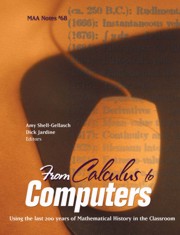Book contents
- Frontmatter
- Preface
- Contents
- Introduction
- I Algebra, Number Theory, Calculus, and Dynamical Systems
- II Geometry
- 6 How to Use History to Clarify Common Confusions in Geometry
- 7 Euler on Cevians
- 8 Modern Geometry after the End of Mathematics
- III Discrete Mathematics, Computer Science, Numerical Methods, Logic, and Statistics
- IV History of Mathematics and Pedagogy
- About the Authors
7 - Euler on Cevians
from II - Geometry
- Frontmatter
- Preface
- Contents
- Introduction
- I Algebra, Number Theory, Calculus, and Dynamical Systems
- II Geometry
- 6 How to Use History to Clarify Common Confusions in Geometry
- 7 Euler on Cevians
- 8 Modern Geometry after the End of Mathematics
- III Discrete Mathematics, Computer Science, Numerical Methods, Logic, and Statistics
- IV History of Mathematics and Pedagogy
- About the Authors
Summary
Introduction
For mathematicians looking to incorporate historical sources into their classroom teaching, Leonhard Euler is of special interest. His mathematical notation closely approximates contemporary use, and his prose style is clear and not forbiddingly concise. Furthermore, he was active just before the era of increasing abstraction in mathematics, so that almost any problem he takes up is of immediate interest to a contemporary undergraduate. The motivation for the problem is usually clear, and it is seldom difficult for the student to come up with lines of further research, either by proving his results using modern techniques, generalizing them, or investigating related questions. Quite often, too, Euler's problem lies somewhat off the beaten track of contemporary mathematics, so that a student's further work stands some chance of resulting in new mathematics.
The present article is a historical examination of a little-known contribution of Euler to classical Euclidean geometry, combined with a free-floating elaboration on some of Euler's results. We firmly believe that this two-pronged approach provides a feasible method for the introduction into the mathematics classroom of historical material that might be stimulating to students and teachers alike (as opposed to only the former or, worse, just the latter). The main body of the paper may be adapted to classroom use, either in the form of lectures, in the form of exploratory activities, or as a combination of the two. Alternatively, parts of the text may be assigned as outside-class reading.
- Type
- Chapter
- Information
- From Calculus to ComputersUsing the Last 200 Years of Mathematics History in the Classroom, pp. 75 - 92Publisher: Mathematical Association of AmericaPrint publication year: 2005
- 1
- Cited by



